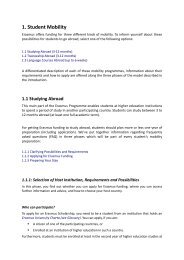NICE HANDBOOK â Academic training of Career ... - Nice-network.eu
NICE HANDBOOK â Academic training of Career ... - Nice-network.eu
NICE HANDBOOK â Academic training of Career ... - Nice-network.eu
Create successful ePaper yourself
Turn your PDF publications into a flip-book with our unique Google optimized e-Paper software.
<strong>NICE</strong> Handbook8.4. <strong>Career</strong> Counselling as aSupport <strong>of</strong> Self-OrganisationChristiane SchiersmannAs we are faced with complex situations in the CGC process due to a complex world with rapidchanges, basic cause-effect models do not represent an appropriate basis for strategies, whichhelp people to take decisions, solve problems and to foster change. From my perspective asystemic paradigm, in the sense <strong>of</strong> a framework theory, is consequently a suitable answer. Systemicapproaches seek to identify patterns and rules, as well as the interplay between differentelements, rather than searching for mono-causal influences.The term “systemic” has become an in-word and covers many different approaches. In myfollowing arguing I refer to the theory <strong>of</strong> synergetics developed by Haken/ Schiepek (2010),a meta-theory which focuses on the self-organization <strong>of</strong> systems. From the perspective <strong>of</strong> Synergetics,the role <strong>of</strong> a CGC pr<strong>of</strong>essional is to support clients’ processes <strong>of</strong> self-organizationregarding their careers. The relevant system <strong>of</strong> a CGC intervention depends on the situation<strong>of</strong> a person and her concern: It could be limited to the person, or could be a social system (e.g.an organisation). Similarly, the elements <strong>of</strong> the system can comprise intrapersonal factors (e.g.emotions) as well as interpersonal relations; again depending on the subject <strong>of</strong> the CGC intervention.The theory <strong>of</strong> Synergetics originated in physics in the late nineteen-sixties through the work <strong>of</strong>Hermann Haken who could explain the laser light as the result <strong>of</strong> the self-organized interaction<strong>of</strong> single elements (Haken/Schiepek, 2010). Next to a theoretical explanation, he provided detailedmathematical algorithms. Since then, the general approach <strong>of</strong> Synergetics has diffusedinto many other research disciplines which deal with complex systems, such as chemistry,biology, economics, sociology, electrical engineering, and psychology. In psychology, it so farhas received the greatest attention in regards to psychotherapy, but can easily be transferredfrom there to career guidance and counselling (Schiersmann/Thiel 2012b).A complex system is about the ultimately unpredictable, reciprocal cooperation <strong>of</strong> variouselements and processes forming synergies. According to Synergetics, processes <strong>of</strong> feedbacklead to the emergence <strong>of</strong> new orders or modified patterns (referring to cognition, emotionand behaviour). Due to processes <strong>of</strong> positive feedback, relatively small variations can triggerthe dormant change potential and thus lead to far-reaching effects. This concept is perhapsbest illustrated through the famous example from chaos theory, indicating that the flap <strong>of</strong> abutterfly’s wing can cause a fierce tropical storm. In other words, new orders form automaticallyas a consequence <strong>of</strong> the reciprocal interaction <strong>of</strong> various elements <strong>of</strong> a system. Hence, a‘self-organizing system’ does not have a central control system.Generic PrinciplesFrom the theory <strong>of</strong> self-organization <strong>of</strong> complex, dynamic systems and the findings <strong>of</strong> psychotherapyresearch, Haken/Schiepek (2010, 436 ff., 628 ff.) have derived so-called “genericprinciples” for (psychotherap<strong>eu</strong>tic) interventions. The idea is that the continuous consideration<strong>of</strong> these principles substantially encourages and supports self-organizing developmentprocesses: the counsellor’s job consists <strong>of</strong> realizing these principles in order to create suchconditions that support the client’s self-organization. The generic principles can be consideredas criteria for high-quality counselling as well as ethical standards for responsible counselling.The generic principles are related to what is called “common factors” in psychotherapy research:empirical evidence on the most relevant aspects <strong>of</strong> successful therapies (Haken/Schiepek2010). Focusing on generic principles allows using and combining methods and proceduresfrom different counselling concepts (Haken/Schiepek, 2010, 440). The relation betweenmethods/techniques and generic principles is ambiguous: one principle can be realized usingdifferent specific methods, and one method can also serve the implementation <strong>of</strong> several principles(Haken/Schiepek, 2010, 440 ff.). The generic principles are not to be understood as aphase concept; however some <strong>of</strong> them are <strong>of</strong> more relevance in certain stages <strong>of</strong> counsellingprocesses. In the following I will explain these principles briefly (for more detailed descriptionsee Schiersmann/Thiel, 2012).◆◆Creating a stable environment for changeCounselling processes involve the destabilization <strong>of</strong> well-known routines and the transition<strong>of</strong> patterns from the perspective <strong>of</strong> Synergetics. Therefore one <strong>of</strong> the CGC pr<strong>of</strong>essional’s maintasks is to create a stable environment for the process <strong>of</strong> change and thus to generate structuraland emotional security for the client: Three main aspects are included in this principle:All steps creating a ‘safe place’ are part <strong>of</strong> the aspect <strong>of</strong> structural stability. This has to do with apleasant ambiance as well as the counsellor’s efforts to explain the proposed procedure includingcertain constraints (e.g. location, duration) and thus make it transparent. Also the quality<strong>of</strong> the relationship between the consulter and the counsellor as well as the consulter’s trustin the counsellor (in his competency, credibility and emotional stability) is an issue referringto emotional security. Besides, the principle has to do with the support that the client derivesfrom himself, e.g. the experience <strong>of</strong> self-efficacy, access to personal resources.When implementing this generic principle, the core concepts <strong>of</strong> person-centred counselling,namely empathy, appreciation and congruency are <strong>of</strong> utmost importance. But it can also beshown by example, that an advantage <strong>of</strong> the general theoretical approach is that different styles<strong>of</strong> communication can be integrated. A counsellor with a systemic background might <strong>of</strong>ferdifferent perspectives <strong>of</strong> the situation for example, e.g. asking what the colleagues, the wife,and the parents would think about the situation being in the focus. A solution-focused counsellormight ask for exceptions from the problematic situation which is the reason for seekingadvice, in order to support the client’s self-esteem.Trends and Developments156 157






